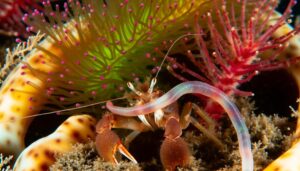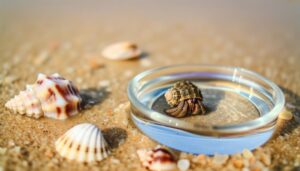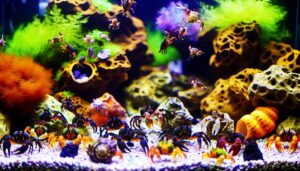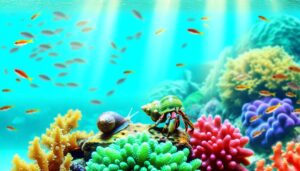Do Hermit Crabs Eat Wood?
Hermit crabs don't typically hunt starfish, but they'll consume them opportunistically. Your hermit crabs' diet mainly includes organic matter, protein, and carbohydrates.
In the wild, they scavenge on decaying material. Field studies show hermit crabs eating injured or deceased starfish, using their chelae to dismember the prey.
Though they lack specialized appendages for hunting, they exploit available food sources opportunistically. Their interaction with starfish is more incidental than predatory.
Hermit crabs' diverse feeding behavior plays a role in ecosystem dynamics, impacting both their health and environment. Discover more about their fascinating dietary habits and ecological roles.
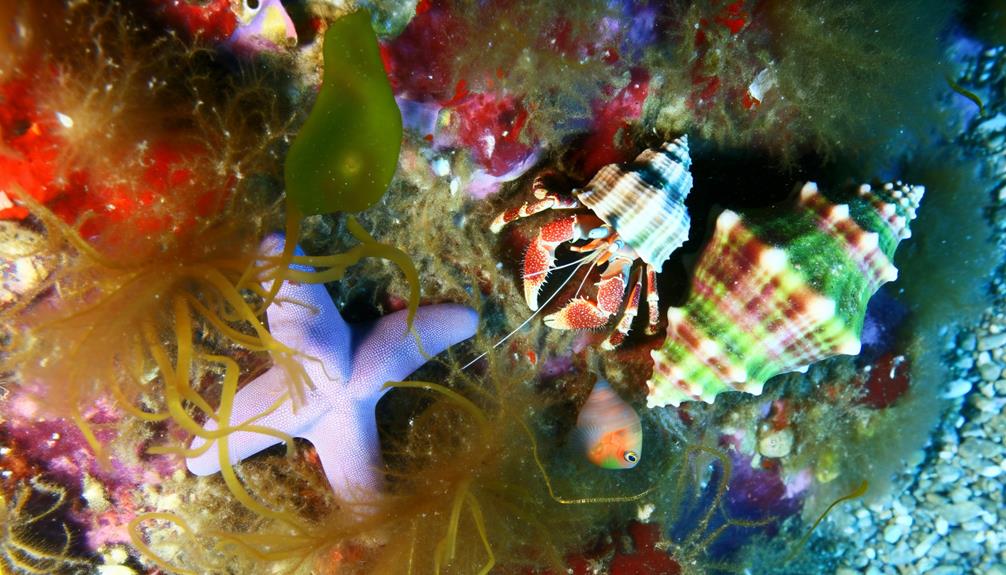
Key Takeaways
- Hermit crabs primarily scavenge and may opportunistically feed on injured or deceased starfish.
- Hermit crabs lack specialized appendages and defenses to actively hunt starfish.
- Instances of hermit crabs consuming starfish are rare and opportunistic.
- Hermit crabs are mainly scavengers and not specialized predators of starfish.
- Hermit crab interactions with starfish are incidental and not a regular part of their diet.
Hermit Crabs' Diet
Hermit crabs' diets primarily consist of a diverse range of organic materials, including algae, decaying wood, and small invertebrates. To make sure their nutritional needs are met, you'll need to provide a balanced diet rich in proteins and carbohydrates. Research indicates that hermit crabs exhibit omnivorous feeding behaviors, meaning they consume both plant and animal matter. Evidence shows that they benefit from a variety of foods, such as cuttlebone for calcium, and fish flakes for essential nutrients.
Starfish as Prey
Despite their varied diet, there's limited evidence to suggest that hermit crabs actively prey on starfish in natural settings. Hermit crabs are primarily scavengers, feeding on detritus, algae, and decaying organic matter.
While there are occasional reports of hermit crabs consuming starfish, these instances are typically opportunistic rather than predatory behavior. Hermit crabs lack the specialized appendages and chemical defenses needed to effectively hunt and subdue starfish. Studies indicate that hermit crabs might nibble on injured or dead starfish, but they don't actively seek them as prey.
Therefore, while hermit crabs exhibit a broad dietary range, their interactions with starfish are more incidental and opportunistic rather than a deliberate predatory strategy. This reflects their adaptive, scavenging lifestyle in marine ecosystems.
Natural Predators of Starfish
You'll find that starfish face numerous threats from marine predatory species such as sharks, manta rays, and certain fish. These predators often exploit the starfish's relatively slow movement and limited defensive capabilities.
However, starfish possess unique defense mechanisms, including the ability to regenerate lost limbs and secrete toxic substances to deter attackers.
Marine Predatory Species
Among marine ecosystems, starfish face predation from a variety of species, including fish, sea otters, and certain types of crustaceans, which play essential roles in maintaining ecological balance. Predatory interactions are pivotal for regulating starfish populations and preventing overgrazing on coral reefs and kelp forests. Fish such as pufferfish and triggerfish often predate on starfish by breaking through their tough exterior. Sea otters are known to consume starfish as part of their diverse diet. Certain crustaceans, including crabs and lobsters, also target starfish, utilizing their powerful claws.
| Predator Type | Example Species | Predatory Behavior |
|---|---|---|
| Fish | Triggerfish | Breaks through starfish exoskeleton |
| Mammals | Sea Otters | Consumes starfish in diverse diet |
| Crustaceans | Crabs, Lobsters | Uses claws to prey on starfish |
Understanding these dynamics helps in marine conservation efforts.
Starfish Defense Mechanisms
Starfish have evolved a range of intricate defense mechanisms, including the ability to regenerate lost limbs and secrete noxious chemicals, to deter natural predators such as fish, sea otters, and crustaceans. These adaptations are essential for their survival in the harsh marine environment.
When a predator attacks, a starfish can employ several strategies:
- Limb Regeneration: If caught, a starfish can shed an arm that continues to move, distracting the predator.
- Chemical Secretion: Starfish can release substances that are toxic or distasteful, discouraging further predation.
- Camouflage: Their ability to blend into the ocean floor helps them evade detection.
Hermit Crab Species
You'll find that hermit crab species vary greatly in their common types, natural habitats, and diets.
Evidence suggests that while some species inhabit coastal areas and primarily consume detritus, others reside in deeper waters with a more varied diet, including algae, plankton, and small invertebrates.
Analyzing these factors can provide insight into whether hermit crabs might indeed prey on starfish.
Common Hermit Crab Types
With over 800 species, hermit crabs exhibit a fascinating array of adaptations that make them an engaging subject for marine biologists. You'll find that some species are more prevalent and studied than others.
- Pagurus bernhardus: Known as the common hermit crab, it's found in the Atlantic Ocean and is noted for its symbiotic relationship with sea anemones.
- Clibanarius tricolor: This species, also known as the blue-legged hermit crab, is popular in reef aquaria due to its bright coloring and algae-eating habits.
- Coenobita clypeatus: Also called the Caribbean hermit crab, it's terrestrial and often kept as a pet due to its adaptability to various environments.
These species exemplify the diversity in morphology, behavior, and ecological roles among hermit crabs.
Natural Habitats & Diets
Understanding the natural habitats and diets of hermit crab species reveals how their diverse environments shape their feeding behaviors and dietary preferences.
Coastal hermit crabs, found in intertidal zones, primarily consume algae, detritus, and small invertebrates. In contrast, terrestrial species, residing in tropical forests, feed on fruits, decaying wood, and leaf litter.
Evidence indicates that environmental factors directly affect nutrient intake and foraging strategies. For instance, hermit crabs in nutrient-poor regions exhibit opportunistic feeding, occasionally preying on starfish if accessible.
Feeding Habits in Captivity
In captivity, hermit crabs exhibit a diverse diet that can include various foods such as fruits, vegetables, and protein sources, although they typically don't prey on starfish. Research indicates that these dietary items help maintain their health and longevity.
You should focus on providing a balanced diet by incorporating:
- Fruits: Apples, bananas, and grapes offer important vitamins.
- Vegetables: Carrots, spinach, and broccoli supply necessary minerals and fiber.
- Protein sources: Boiled eggs, fish flakes, and shrimp provide vital amino acids.
Offering a variety of these foods ensures your hermit crabs receive the nutrients they need.
Observations show that a well-rounded diet supports their exoskeleton development and overall well-being.
Always make sure fresh, clean water is available to facilitate hydration and proper digestion.
Ecological Interactions
Hermit crabs play an important role in their ecosystems by scavenging for detritus and maintaining the health of marine environments.
You'll find that their interaction with starfish is multifaceted. Hermit crabs primarily consume dead organic matter, but under specific conditions, they might prey on weakened or injured starfish. This predation is opportunistic rather than habitual.
By consuming detritus, hermit crabs contribute to nutrient cycling, enhancing water quality and promoting coral reef resilience. Their activities help decompose organic material, preventing algal blooms and supporting biodiversity.
Understanding these interactions is vital for marine conservation efforts. By appreciating hermit crabs' ecological roles, you're better equipped to advocate for balanced, thriving marine habitats.
Observations and Studies
Numerous studies have documented hermit crabs' feeding behaviors, providing valuable insights into their occasional predation on starfish. Researchers have observed specific scenarios where hermit crabs exhibit this behavior, often influenced by environmental conditions and resource availability.
Key observations include:
- Controlled Laboratory Settings: Experiments show hermit crabs preying on starfish when other food sources are scarce, highlighting adaptive foraging strategies.
- Field Studies: In natural habitats, hermit crabs have been seen scavenging on injured or deceased starfish, indicating opportunistic feeding.
- Behavioral Analysis: Detailed recordings reveal hermit crabs using their chelae to dismember starfish, underscoring their capability to exploit various food sources.
These findings underscore the importance of understanding hermit crabs' dietary flexibility, aiding in more effective conservation and habitat management strategies.
Conclusion
To sum up, you'll find that while hermit crabs can eat starfish, they do so infrequently and under specific conditions.
'Nature abhors a vacuum,' meaning ecological interactions are complex and varied.
Studies show that hermit crabs' diets depend on species and habitat, with starfish forming a minor part of their consumption.
In captivity, their feeding habits adapt to available food sources, highlighting the importance of understanding their natural behaviors for effective care and ecological balance.

